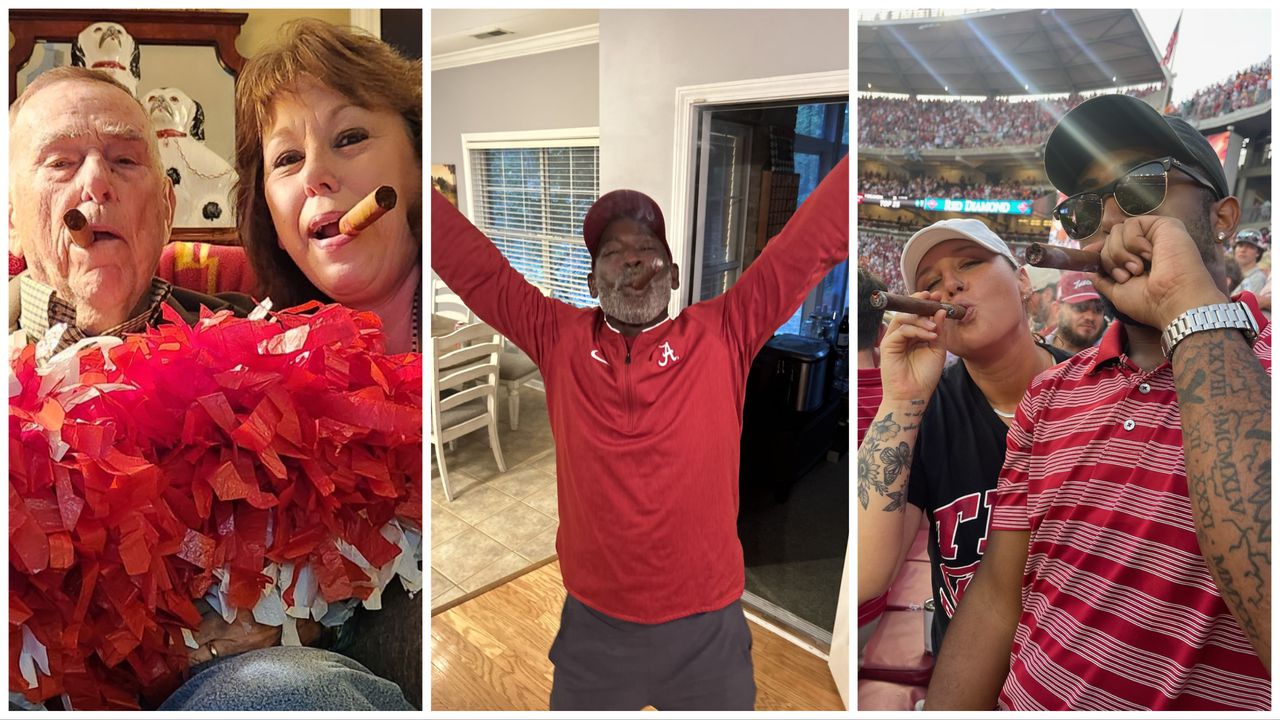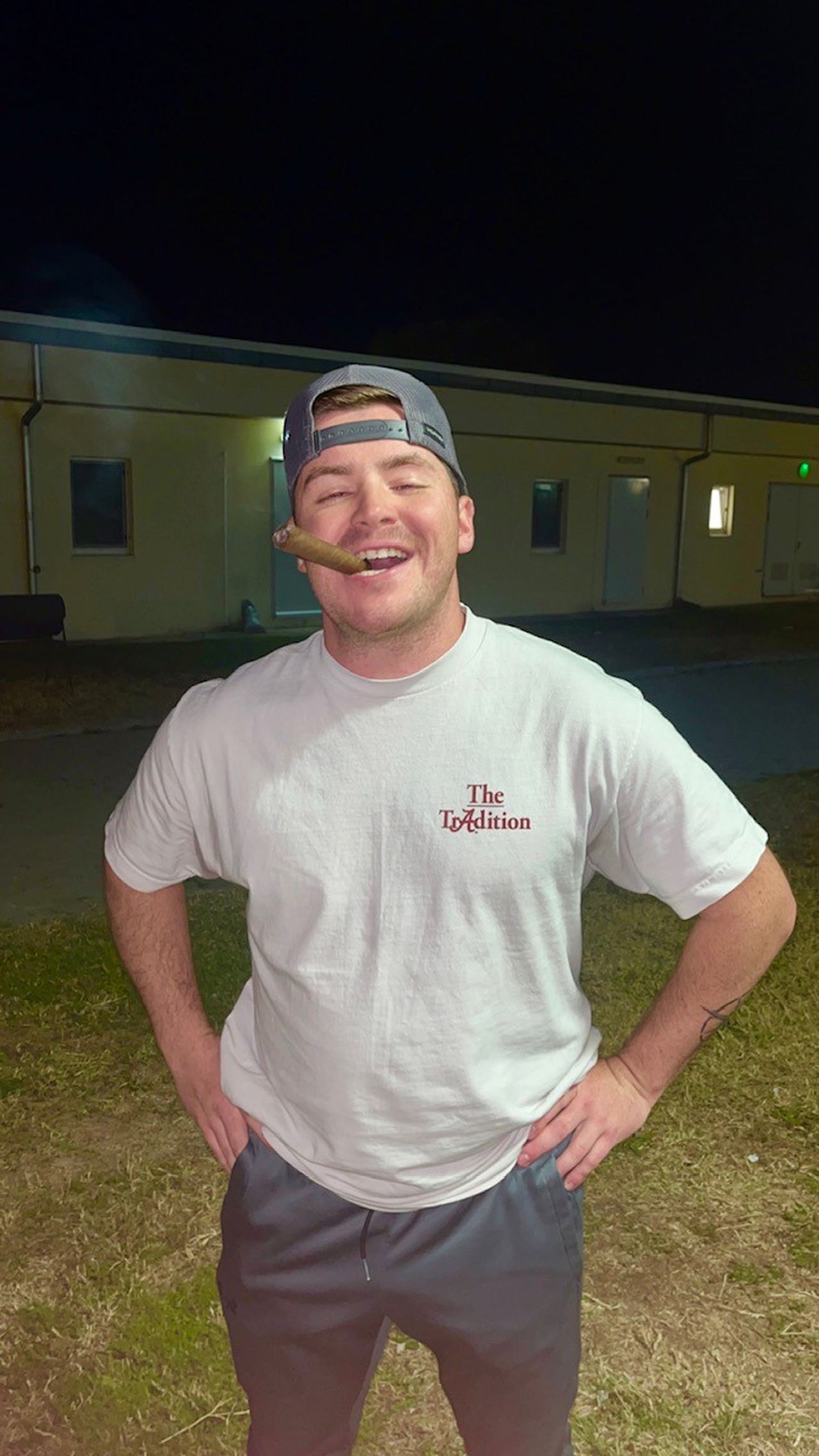How the Alabama-Tennessee cigar tradition evolved in a new era of college football
Shades of orange and crimson filtered into Bryant-Denny Stadium. The Tuscaloosa fall afternoon was idyllic for a football game and, if you wanted to partake, a collective act of permitted civil disobedience.
Shortly before Alabama and Tennessee kicked off, a message reminding fans the University of Alabama was a smoke-free campus flashed on four video boards. The public address announcer politely informed everyone that smokeable tobacco products were blacklisted items. He ended with a plea knowing full well what was coming: “Be courteous of those around you.”
As it has since 2005, a biennial Tuscaloosa tradition endured. The Tide beat the Vols. Spectators unsheathed their cigars and ignited them. Nick Saban chewed the end of one live on CBS postgame. One UA player darted toward the sideline and took a puff from a fan’s stogie. Meanwhile, public safety officers, the NCAA, the fun police and the actual TPD looked the other way. This was how a victory on the Third Saturday in October is observed: Smoke ‘em if ya got ‘em.
The Crimson Tide and Volunteers have met every year since 1928. Jim Goostree, a Tennessee grad and trainer on Bear Bryant’s Alabama staff, is credited with the legend after a Tide ended a five-game UT streak at Legion Field in 1961: Goostree danced around the locker room naked, smoking a victory cigar, boosting a mini-economy 70 years later.
The popularity faded over time before making a public revival in the mid-2000s, coinciding with Saban’s hire and the start of a 15-game Tide run of wins against UT. Saban has said he doesn’t smoke, but that doesn’t mean he doesn’t respect what Goostree’s gag has meant for generations.
Traditions in the modern era of college football are an endangered species. Some conferences are trying to curb field and court stormings. Some conferences are expanding, and others disappearing altogether, ending rivalries. The authenticity the sport is known for is buckling under its commerciality. But in Tuscaloosa and Knoxville, the smoky custom lingers.
“As far as (this) tradition goes, this is pure class,” said Reagan Starner, president of R&R Cigars, a local business that’s provided the team its smokes since 2005. “There’s a lot of kids, they come in here and they’re like, ‘I don’t even know what I’m doing, but I’m supposed to get a cigar, right?’ We teach them how to cut it, how to light it. Whether they end up doing that or not, I have no idea. But I always tell them, just put it in your pocket.
“When you have 20,000 students lighting up their cigars what are you gonna do, arrest all of them? Sir, this is Tuscaloosa. Where you gonna put them?”
A new security measure was added this season around Bryant-Denny Stadium. An initial screening fence lined with metal detectors encircles all of the main gates. Then, bags are checked, tickets are scanned and you’re allowed in.
“No way it’s that easy,” one UA student remarked to his three friends as they crossed the North entrance near the Walk of Champions. They had just made it through security and shared a look of excitement.
In the past, it was alleged that Alabama would self-report the distribution of cigars to players as a low-level NCAA violation. Though public disclosures from the last five years haven’t mentioned any. The University of Alabama campus went “smoke-free” on January 6, 2015. That fall, the Tide won and Derrick Henry took the now-famous locker room photo with Nick Saban. Coincidentally, that was the first year R&R Cigars began supplying the Tide.
Notable players like Landon Dickerson, Evan Neal and Jake Coker would stop by the corner of Sixth Street and 27th Avenue and pick up a set for the team or their position groups, Starner said. In a 2023 twist, R&R partnered with Yea Alabama, the University’s NIL entity for an event the Friday before the game. The big seller is the Casa de las Estrellas, his family blend, for locals and enthusiasts looking to smoke the same brand as the players.
Starner made sure to brand each “Estrellas” with the names of his parents, Randy and Debbie Starner on ribbons along the label. There’s also “The Luke” named after his late friend and Alabama superfan Luke Ratliff, the same variety Saban was presented with by CBS sideline reporter Jenny Dell postgame.
“I just kind of chew on one for a little bit,” Saban said. “I think games like this that have sort of special innuendos that go with them, it’s probably good for the players. It’s probably good for the players’ relationships with each other to do things like that. I don’t think there’s anything bad about it.”
If the SEC goes with the rumored perma-opponent system past 2024, the Vols, Auburn and LSU would be Alabama’s yearly games. A nine-game rotation could see Alabama and Tennesseee meeting once every three or four years. Starner worries that if the matchup isn’t annual, the popularity could once again wane.
For the time being, the final scheduled game in Tuscaloosa between the rivals seemed over midway through the fourth quarter. UA linebacker Jihaad Campbell returned a fumble 24 yards for a touchdown and a two-score lead and smoke billowed from pockets of the crowd. There weren’t enough lighters to go around, so some fans smushed cigars together to spread the flame. One fan swayed to a well-timed playing Dixieland Delight, a Michelob Ultra nestled in a koozie, and dug a hand into his pocket. He fished out a stogie to start his celebration, a security guard on either side of his section.
The party continued on the field, in the Alabama locker room and state-wide. The lower bowl student section remained abuzz and soon the players roared back onto the field and into the stands. Senior linebacker Deontae Lawson and a couple of others found 2024 UA commit and Spanish Fort’s Sterling Dixon and posed for the camera: the present and future of the tradition captured in the haze.
Nick Alvarez is a reporter for Alabama Media Group. Follow him on Twitter @nick_a_alvarez or email him at [email protected].

